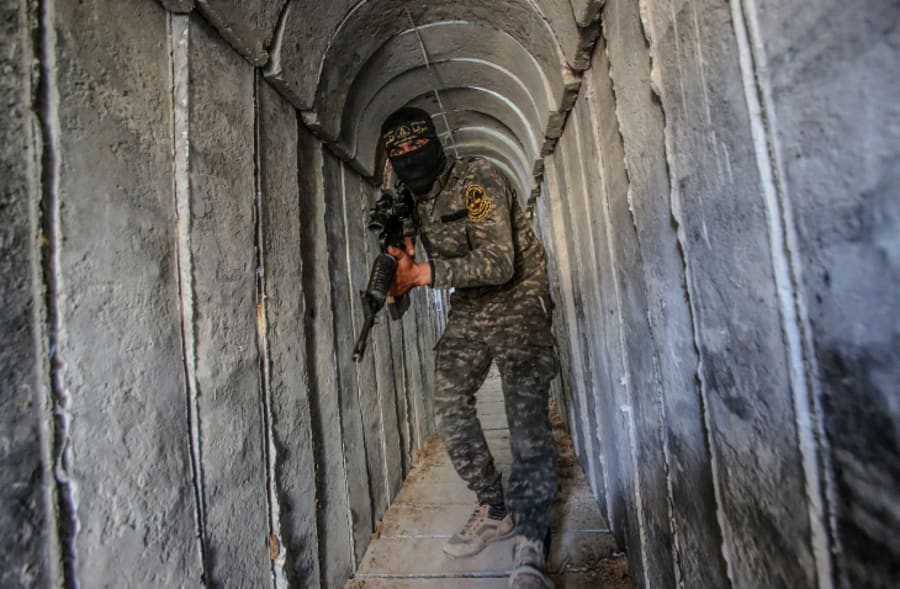Documents found in Gaza reveal Hamas strategy for tunnel warfare, developed years before Oct 7
Manual reveals extent of Hamas' preparations for an Israeli ground campaign in Gaza

IDF troops in the Gaza Strip recently discovered a Hamas manual for tunnel warfare, which describes in detail how to maneuver and fight in dark underground spaces.
The manual, which was written in 2019, five years before the Oct. 7 Hamas invasion, revealed that the terror group was already planning to fight the IDF in Gaza, and had been planning to use the tunnels as a major component of their strategy.
Israel Defense Forces provided a copy of the manual to the New York Times. In an article, the NYT said the “markings on the documents are consistent with other Hamas materials that have been made public or been examined by The Times.”
The manual included instructions for Hamas fighters operating in the tunnels.
“While moving in the dark inside the tunnel, the fighter needs night-vision goggles equipped with infrared,” according to the manual. In addition, Hamas fighters are told to hold their rifles at shoulder height in an automatic setting. “This type of shooting is effective because the tunnel is narrow, so the shots are aimed at the kill zones in the upper part of the human body.”
The Hamas tunnel network was well known to Israel before the war in Gaza, however, the full scale and sophistication of the network have significantly surpassed the IDF's prior knowledge.
Nearly every week since the ground campaign began, the IDF has announced the discovery and destruction of an additional section of the massive tunnel network.
Hamas leader Yahya Sinwar is believed to have spent most of the war hiding underground in the extensive tunnel network, which at one point spanned the entire Gaza Strip from north to south.
Tamir Hayman, a former head of Israel’s military intelligence stated, “Hamas’s combat strategy is based on underground tactics. This is one of the primary reasons they have managed to withstand the IDF thus far.”
However, it appears that the IDF has successfully adapted its tactics, limiting Hamas' use of the tunnels despite the extensive plans. By avoiding direct entry into tunnels discovered in active combat zones, the IDF has prevented Hamas from turning them into places for ambush.
While Hamas continues to use the tunnels to harass Israeli soldiers, including staging successful “hit-and-run attacks,” the expected underground battle has yet to take place.
Instead, the IDF has taken a slow, measured approach to identifying tunnels, using drones or dogs to search out tunnel segments, looking for booby traps and signs of hostages, and then destroying the segments after inspecting them for any useful intelligence information.
The destruction has also compromised Hamas’ ability to use the tunnels as effectively as they previously envisioned.
Before Oct. 7, the IDF invested most of its anti-tunnel efforts into locating tunnels that crossed into Israeli territory. The vast tunnel network within Gaza was not a priority, as commanders did not anticipate a large-scale ground campaign in the Gaza Strip.
The manual revealed that Hamas was planning for such a confrontation by instructing its fighters how to hide tunnel shaft entrances, how to find the shafts using GPS, and how to move effectively once inside the tunnels.
Earlier this year, the IDF located rooms which had been prepared for holding hostages. They found telecommunications systems to enable underground communication, including some connected to hospitals and UN facilities.
The sheer extent of the tunnel network has also slowed down IDF operations in the Strip. Daphné Richemond-Barak, a tunnel warfare expert at Reichman University in Israel, told the Times, “The tunnels impact the pace of the operations.”
“You can’t advance. You can’t secure the terrain,” she said, adding that the IDF is “dealing with two wars, one on the surface and one on the subsurface.”
A letter from Sinwar to Mohammed Deif, written before the Oct. 7 attacks, indicated the extensive efforts and cost to prepare for the anticipated conflict.
In the letter, Sinwar told Deif that “the brigades will be given the money according to the level of importance and necessity.”
Hamas dedicated most of its money to the tunnel system in northern Gaza and the Hamas stronghold city of Khan Younis, including installing blast doors meant to minimize the effectiveness of IDF bombs and slow down Israeli troops entering the tunnels.
Israeli soldiers discovered the Hamas tunnel warfare manual in the Zeitoun neighborhood of Gaza City in November.

The All Israel News Staff is a team of journalists in Israel.
You might also like to read this:














